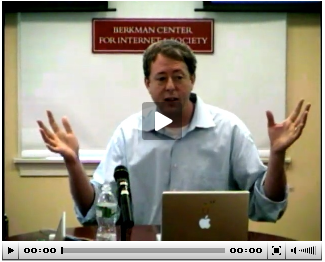I’ve mentioned Chris Kelty‘s Two Bits as part of my summer reading list. Although I have the PDF sitting in my “to read” folder I think I’m waiting on the hardcover I ordered from Amazon. Seems like the kind of book that requires more reflective reading.
In the meanwhile, here’s Chris presenting at a Berkman Luncheon Series event on June 17th, 2008:

The Berkman description:
A discussion of the recently published book, Two Bits, which will focus on the meaning and cultural significance of Free Software, its history and the manner in which it has been “modulated” into domains both close to and far from software and networks. Topics for discussion include anthropological approaches to studying distributed phenomena, the historical analysis of Free Software and the use of Free Software practices in education, science, music and culture generally.
Unfortunately I was out of town – in Chicago for Web Content 2008 – and unable to attend in person. Nice to see Benjamin Mako Hill, danah boyd, and Ethan Zuckerman (and, I’m sure, others who I don’t recognize by sight but would know by name and reputation) in the question and answer segment. That’s the kind of crowd you’ll really only get at a Berkman event.
Here are my rough notes from the talk, which are really more an outline of the topics discussed than what Chris has to say about them – for that you’ll have to watch.
Overview of the book:
I. Ethnographic and Theoretical Introduction: Hackers, Geeks, and Recursive Publics
II. Analytic History of Free Software – Five Practices which make Free Software
III. Modulations of those practices into other domains
Part One:
The important thing is the subtitle – the cultural significance of free software.
What would it mean to do an anthropology of free software?
Ability to participate in building the internet – recursive publics: the thing that draws them together is the thing they are building in common.
Part Two:
Breaking Free software into 5 practices / domains.
- fermenting a movement
- sharing source code
- defining an open infrastructure
- writing copyleft licenses
- coordinating collaboration
Part Three: Modulations, carrying “free software” into non-software domains
College Textbooks – Connexions (collaborative textbook creation using creative commons licenses). (At Rice University)
Biology: BiOS, Registry of Standard Biological Parts, patent Lens, open source nanotechnology
Bio Nano: ATCC (Global Bioresource Center)
Difficulty of patents, not just copyright, in some of these other domains.
—
It’s interesting to me how much Chris focuses on the moment in 1998 when “Free Software” and “Open Source” underwent a decisive split, and how the distinction between the two plays out in the “Modulations” section. What difference does it make if the modulations are actually versions of “open source” in other domains rather than “free software” in other domains?
Of course, the book isn’t subtitled “The Cultural Significance of Open Source,” so one assumes the focus is more on the free software version – which focuses more specifically on copyleft, and ensuring (some might say requiring) freedom for downstream users – but when my copy finally arrives I’ll post some further discussion about what impact those differences might have. Would the more traditionally business friendly “open source” approach have made modulation into other domains easier, but perhaps less impactful?